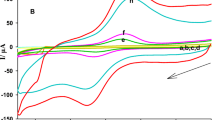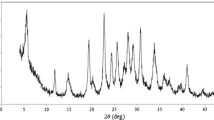Abstract
A modified carbon paste electrode with Sn(II)-exchanged clinoptilolite nanoparticles (CNP-Sn(II)-CPE) showed voltammetric current (in cyclic voltammetry (CV)) for Sn(II)/Sn(IV) in sulfuric acid electrolyte (pH 2). The peak current was decreased when bromate was added to the solution. Hence, this decrease was used for indirect voltammetric determination of bromate. In designed experiments using response surface methodology (RSM) approach in square-wave voltammetry (SqW), strong acidic pH values (pH 1.8–2.5) caused an increased SqW voltammetric response, because such pH values bring sufficient Sn(II) as the electroactive species at the electrode surface via ion-exchange process. The optimal variables obtained are sulfuric acid as supporting electrolyte at pH 1.80, modifier% at 25, amplitude at 498.4 mV, step potential at 5.4 mV, and frequency at 25 Hz. The peak current of Sn(II)/Sn(IV) redox pair was inversely proportionate to the concentration of bromate. Hence, ΔI (difference in peak current in the absence and presence of bromate) was proportionally increased with increasing the concentration of bromate in the range of 5.00 to 100.00 μmol L−1 with a detection limit of 0.06 μmol L−1 bromate. The effect of some strong oxidizing agents was studied, and the results showed that when such agents are present at levels of 2.5 to 5 times greater than the bromate in the solution, they can cause a maximum error of 3% in the determination of bromate in sulfuric acid electrolyte at pH 2.5.






Similar content being viewed by others
References
Pfaff J, Brockhoff C, O’Dell J (1991) The determination of inorganic anionsin water by ion chromatography. Method 300.0 revised. US Environmental Protection Agency, Cincinnati
Thomas H, Matthew J, Keith W (1997) A review of the effects of bromate on aquatic organisms and toxicity of bromate to oyster (Crassostreagigas) embryos. Ecotoxicol Environ Saf 38:238–243
Legube B, Bourbigot M, Bruchet A, Deguin A, Montiel A, Matia L (1997) Bromide/bromate survey on different European water utilities. In: International workshop on bromate and water treatment, Paris, France 22: 135–139
Michalski R, Olsinska U (1996) The determination of bromates in water by means of ion chromatography. Acta Chromatogr 6:127
Song R, Minear R, Westerhoff P, Amy G (1997) Modelling and risk analysis of bromate formation from ozonation of bromide-containing waters. Water Sci Technol 79:34/7–34/8
WHO (1993) Guidelines for drinking water quality, tables of guidelines values. WHO, Geneva
Yan Z, Zhang Z, Liu Z, Chen J (2016) Chemiluminescence determination of potassium bromate in flour based on flow injection analysis. Food Chem 190:21–24
Mario M, Maria T Fernandez A, Jose M, Costa F, Pereiro R, Sanz Medel A (2013) Room temperature phosphorimetric determination of bromate in flour based on energy transfer. Talanta 116:231–236
Ketai W, Huitao L, Jian H, Xingguo C, Zhide H (2000) Determination of bromate in bread additives and flours by flow injection analysis. Food Chem 4:509–514
Inoue Y, Sakai T, Kumagai H, Hanaoka Y (1997) High selective determination of bromate in ozonized water by using ion chromatography with postcolumn derivatization equipped with reagent preparation device. Anal Chim Acta 346(3):299–305
Kolpakova NA, Oskina YA, Sabitova ZK (2018) Determination of Rh(III) by stripping voltammetry on a graphite electrode modified with lead. J Solid State Electrochem 22(6):1933–1939
Ehsani A, Hadi M, Kowsari E, Doostikhah S, Torabian J (2017) Electrocatalytic oxidation of ethanol on the surface of the POAP/ phosphoric acid-doped ionic liquid-functionalized graphene oxide nanocomposite film. Iran J Catal 7:187–192
Vedhi C, Selvanathan C, Arumugam P, Manisankar P (2009) Electrochemical sensors of heavy metals using novel polymer-modified glassy carbon electrodes. Ionics 15(3):377–383
Nobahari MH, Golikand AN, Bagherzadeh M (2017) Synthesis and characterization of Pt3Co bimetallic nanoparticles supported on MWCNT as an electrocatalyst for methanol oxidation. Iran J Catal 7:327–335
Leniart A, Brycht M, Burnat B, Skrzypek S (2018) An application of a glassy carbon electrode and a glassy carbon electrode modified with multi-walled carbon nanotubes in electroanalytical determination of oxycarboxin. Ionics 24(7):2111–2121
Noroozifar M, Khorasani-Motlagh M, Bemanadi Parizi M, Akbari R (2013) Highly sensitive electrochemical detection of dopamine and uric acid on a novel carbon nanotube-modified ionic liquid-nanozeolite paste electrode. Ionics 19(9):1317–1327
Abdullah Mirzaie R, Hamedi F (2015) Introducing Pt/ZnO as a new non carbon substrate electro catalyst for oxygen reduction reaction at low temperature acidic fuel cells. Iran J Catal 5:275–283
Taei M, Jamshidi M (2014) Highly selective determination of ascorbic acid, epinephrine, and uric acid by differential pulse voltammetry using poly(Adizol black B)-modified glassy carbon electrode. J Solid State Electrochem 18(3):673–683
Portales MV, Lazo Fraga AR, Díaz García AM, García-Zaldívar O, Barranco AP, Aguilar Frutis MA (2018) Cyclic voltammetry and impedance spectroscopy analysis for graphene-modified solid-state electrode transducers. J Solid State Electrochem 22(2):471–478
Gligor D, Muresan LM, Dumitru A, Popescu IC (2007) Electrochemical behavior of carbon paste electrodes modified with methylene green immobilized on two different X type zeolites. J Appl Electrochem 37(2):261–267
Mehretie S, Losada J, Tessema M, Admassie SH, Solomon TH, Perez Pariente J, Díaz I (2012) Stripping voltammetric determination of pyridine-2-aldoximemethochloride at the iron(III) doped zeolite modified glassy carbon electrode. Analyst 137(23):5625–5631
Walcarius A (1999) Factors affecting the analytical applications of zeolite modified electrodes: indirect detection of nonelectroactive cations. Anal Chim Acta 388(1-2):79–91
Basu M, Ghosh S (2016) Fuel cell applications of chemically synthesized zeolite modified electrode (ZME) as catalyst for alcohol electro-oxidation—a review. J Electroanal Chem 783:308–315
Elizabete M, de Lima F, Claudia ALC, Gilberto J (2018) Modification of carbon paste electrodes with recrystallized zeolite for simultaneous quantification of thiram and carbendazim in food samples and an agricultural formulation. Electrochim Acta 259:66–76
Walcarius A (1999) Electroanalytical applications of microporous zeolites and mesoporous (Organo)Silicas: recent trends. Electroanalysis 20:711–738
Walcarius A (1999) Zeolite-modified electrodes in electroanalytical chemistry. Anal Chim Acta 384(1):1–16
Walcarius A (1999) Zeolite-modified electrodes: analytical applications and prospects. Electroanalysis 8:971–976
Rolison DR (1990) Zeolite-modified electrodes and electrode-modified zeolites. Chem Rev 90(5):867–878
Muresan LM (2011) Zeolite-modified electrodes with analytical applications. Pure Appl Chem 83:325–343
Doménech-Carbó A (2015) Theoretical scenarios for the electrochemistry of porous silicate-based materials: an overview. J Solid State Electrochem 19(7):1887–1903
Bessel CA, Rolison DR (1997) Topological redox isomers: surface chemistry of zeolite-encapsulated co(salen) and [Fe(bpy)3]2+ complexes. J Phys Chem B 101(7):1148–1157
Senaratne C, Zhang J, Baker MD, Bessel CA, Rolison DR (1996) Zeolite-modified electrodes: intra- versus extrazeolite electron transfer. J Phys Chem 100(14):5849–5862
Walcarius A (2006) Zeolite-modified paraffin-impregnated graphite electrode. J Solid State Electrochem 10(7):469–478
Walcarius A, Mariaulle P, Lamberts L (2003) Zeolite-modified solid carbon paste electrodes. J Solid State Electrochem 7(10):671–677
Stephenson MJ, Attfield MP, Holmes SM, Dryfe Robert AW (2015) Electrochemically controlled ion exchange: proton ion exchange with sodium zeolite X and A. J Solid State Electrochem 19(7):1985–1992
Mojović Z, Mudrinić T, Banković P, Jović-Jovičić N, Ivanović-Šašić A, Milutinović-Nikolić A, Jovanović D (2018) Oxygen reduction reaction on palladium-modified zeolite 13X. J Solid State Electrochem 22:31–40
Baker MD, Senaratne C (1994) In: Lipkowski J, Ross PN (eds) The electrochemistry of novel materials. VCH Publishers, New York
Rolison DR (1994) The intersection of electrochemistry with zeolite science. Stud Surf Sci Catal 85:543–586
Bedioui F (1995) Zeolite-encapsulated and clay-intercalated metal porphyrin, phthalocyanine and Schiff-base complexes as models for biomimetic oxidation catalysts: an overview. Coord Chem Rev 144:39–68
Farhadi K, Bahram M, Shokatynia D, Salehiyan F (2008) Optimization of polymeric triiodide membrane electrode based on clozapine–triiodide ion-pair using experimental design. Talanta 76(2):320–326
Zhang C, Yang L, Rong F, Fu D, Gu Z (2012) Boron-doped diamond anodic oxidation of ethidium bromide: Process optimization by response surface methodology. Electrochim Acta 64:100–109
Akiyama T, Yamanaka M, Date Y, Kubota H, Nagaoka MH, Kawasaki Y, Yamazaki T, Yomota C, Maitani T (2002) Specific determination of bromated in bread by ion chromatography with ICP-MS. J Food Hyg Soc Jpn 43(6):348–351
Treacy MMJ, Higgins JB (2001) Collection of simulated XRD powder patterns for zeolites, 4th revised edn. Elsevier, Amsterdam, p 586
Scherrer P (1918) Bestimmung der Grösse und der inneren Struktur von Kolloidteilchenmittels Röntgensrahlen [Determination of the size and internal structure of colloidal particles using X-rays]. Math-Phys Kl German 1918:98–100
Aghabeygi S, Kojoori R, Vakili Azad H (2016) Sonosynthesis, characterization and photocatalytic degradation property of nanoZnO/zeoliteA. Iran J Catal 6:275–279
Doula MK (2007) Synthesis of a clinoptilolite-Fe system with high Cu sorption capacity. Chemosphere 67(4):731–740
Handke M, Mozgawa W (1993) Vibrational spectroscopy of the amorphous silicates. Vib Spectrosc 5(1):75–84
Handke M, Sitarz M, Mozgawa W (1998) Model of silicooxygen ring vibrations. J Mol Struct 450(1-3):229–238
Arthur G, Frank JL (1983) Infrared spectrum of stannous oxide (SnO). J Mol Spectrosc 98:146–153
Courtney TD, Chang C-C, Gorte RJ, Lobo RF, Fan W, Nikolakis V (2015) Effect of water treatment on Sn-BEA zeolite: origin of 960 cm−1 FTIR. Microporous Mesoporous Mater 210:69–76
Doula M, Ioannou A, Dimirkou A (2002) Copper adsorption and Si, Al, Ca, Mg and Na release from clinoptilolite. J Colloid Interface Sci 245(2):237–250
Silverstein R, Bassler GC, Morill TC (1981) Spectromatic identification of organic compounds. Wiley, New York
Nezamzadeh-Ejhieh A, Shirzadi A (2014) Enhancement of the photocatalytic activity of ferrous oxide by doping onto the nano-clinoptilolite particles towards photodegradation of tetracycline. Chemosphere 107:136–144
Zabihi-Mobarakeh H, Nezamzadeh Ejhieh A (2015) Application of supported TiO2 onto Iranian clinoptilolite nanoparticles in the photodegradation of mixture of aniline and 2,4-dinitroaniline aqueous solution. J Ind Eng Chem 26:315–321
Laviron E (1979) General expression of the linear potential sweep voltammogram in the case of diffusionless electrochemical systems. J Electroanal Chem 101(1):19–28
Bard AJ, Faulkner LR (2001) Electrochemical methods: fundamentals and applications, 2nd edn. Wiley, New York, p 398
Azizi SN, Ghasemi S, Chiani E (2013) Nickel/mesoporous silica (SBA-15) modified electrode: an effective porous material for electrooxdation of methanol. Electrochim Acta 88:463–472
Karimi Shervedani R, Bagherzadeh M (2009) Electrochemical impedance spectroscopy as a transduction method for electrochemical recognition of zirconium on gold electrode modified with hydroxamated self-assembled monolayer. Sensors Actuators B 139(2):657–664
Anderson RL (1987) Practical statistics for analytical chemists. Van Nostrand Reinhold, New York
Ding L, Liu Y, Guo SX, Zhai J, Alan MB, Zhang J (2014) Phosphomolybdate@poly(diallyldimethylammonium chloride)-reduced graphene oxide modified electrode for highly efficient electrocatalytic reduction of bromated. J Electroanal Chem 727:69–77
Papagianni GG, Stergiou DV, Armatas GS, Kanatzidis MG, Prodromidis MI (2012) Synthesis, characterization and performance of polyaniline-polyoxometalates (XM12, X=P, Si and M=Mo, W) composites as electrocatalysts of bromates. Sensors Actuators B 173:346–353
Wang J, Serra B, Ly SY, Jose JL, Pingarron M (2001) Determination of micromolar bromate concentrations by adsorptive-catalytic stripping voltammetry of the molybdenum-3-methoxy-4-hydroxymandelic acid complex. Talanta 54(1):147–151
Li ZF, Chen JH, Pan DW, Tao WY, Nie LH, Yao ASZ (2006) Sensitive amperometric bromate sensor based on multi-walled carbon nanotubes/phosphomolybdic acid composite film. Electrochim Acta 51(20):4255–4261
Mao R, Zhao X, Qu J (2014) Electrochemical reduction of bromate by a Pd modified carbon fiber electrode: kinetics and mechanism. Electrochim Acta 132:151–157
Author information
Authors and Affiliations
Corresponding author
Electronic supplementary material
ESM 1
(DOCX 950 kb) The electronic supplementary materials are referred to individually in the main text, but were submitted all collated in a single file. If specific, individual reference to these is required, then please supply each as a separate file, ensuring that the naming conventions used are consistent (e.g., Online Resource #, Supplementary File #, Additional File #).Please use the seprate file that has been attached in revision version, as : Supplementary data
Rights and permissions
About this article
Cite this article
Tamiji, T., Nezamzadeh-Ejhieh, A. Sensitive voltammetric determination of bromate by using ion-exchange property of a Sn(II)-clinoptilolite-modified carbon paste electrode. J Solid State Electrochem 23, 143–157 (2019). https://doi.org/10.1007/s10008-018-4119-4
Received:
Revised:
Accepted:
Published:
Issue Date:
DOI: https://doi.org/10.1007/s10008-018-4119-4




